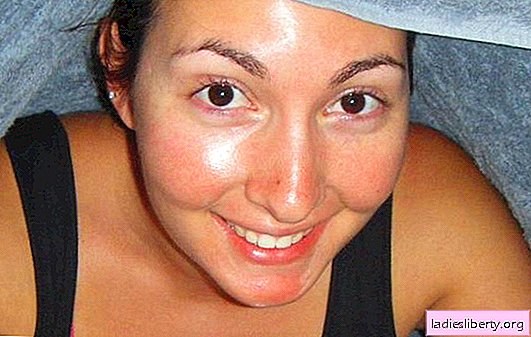
Almost all sudden twitches of the eyelid are benign, that is, they do not signal a serious medical problem. Very rarely, cramps indicate impaired brain activity or nervous breakdown. But ignore the problem. Perhaps this is a signal from the body that it is time to change the usual way of life.
The eye twitches - what happens?
Twitching of the eyelid is an involuntary and repeated muscle spasm in the folds of skin near the eyes. Microcramps usually occur every second for a minute or two. They can be repeated for several days, and then disappear for a long time.
Why does the eyelid twitch? It's all about the electrical impulses of the brain that mistakenly make neurons activate. Brain cells send a signal to the muscles surrounding the eye, where the most sensitive nerve endings are located - thus, twitching of the eyelids occurs. Most people feel these cramps as a gentle jerk, uncontrollable. In isolated cases, sufficiently strong spasms occur, as a result of which the eye closes completely.
In medicine, this phenomenon is called "blepharospasm." Ophthalmic statistics claim that cramps are twice as likely to affect women. At risk are people who have crossed the thirty-year mark. Twitching of the eyelids can be observed in children of primary school and preschool age.
Why the eyelid began to twitch: common causes of an unpleasant syndrome
Usually, taking a closer look at the everyday lifestyle, you can determine why the eyelids twitch. Consider the most likely causes of this phenomenon:
1. Stress. People react differently to unexpected situations, adverse living conditions. Someone can scream, quarrel, break a plate, and someone accumulates all the emotions inside and does not give them a way out. The latter, most often, become victims of a nervous tick. In this case, eye cramps are the result of a psychological problem.
2. Sleep problems. If a person experiences a sleep disorder, then sooner or later it will end with a nervous strain. The appearance of seizures of the eyelids may indicate that the reserves of the body are exhausted and it needs a good rest. A person who has not fully slept for a long time begins to age intensely, physiological and mental processes slow down. Lack of response to bodily signals can lead to a nervous breakdown, depression, weakened immunity.
3. Caffeine. An excess of caffeine in the body leads to excessive brain arousal, too intense physical activity, and insomnia. Do not forget that caffeine is an alkaloid (that is, a drug) that affects the neuronal activity of the brain and energy metabolism in the body. A person who consumes a lot of this substance ceases to feel tired, while the brain experiences overstrain. Caffeine is found not only in coffee, but also in cocoa, Coca-Cola, chocolate, certain medicines, black and green tea.
4. Alcohol. Why are eyelids twitching with drinkers? Alcohol abuser kills inhibitory processes in his brain. The simplest everyday situations become a source of stress and irritation. It is believed that the appearance of ocular teak indicates the development of serious alcohol dependence and the destruction of the nervous system.
5. Overexertion of the optic nerve and dry eyes. As a rule, these two factors are associated with the labor activity of a person. Hours of work at the computer or manufacturing operations, the implementation of which is accompanied by a constant strain of vision, can provoke eye strain. In addition, dry air conditioning and heating, radiation from computer screens, dust and bright light interfere with the natural hydration of the mucous membranes of the organs of vision. As a result, short cramps of the upper or lower eyelids, as well as headaches and visual impairment.
6. Nutrition flaws. For the full functioning of the nervous system, the human body needs substances such as magnesium and B vitamins. A poor and uniform diet leads to an imbalance in metabolic processes. Often, all kinds of long-term diets and poverty are to blame.
7. Contact allergy. The eye is a very sensitive organ that can respond to various allergens in the environment: fluff and pollen of plants, dust, chemicals, animal hair, and even cold. In this case, a person develops intolerable itching and cutting sensations in the eyes, increased lacrimation, swelling and cramping of the eyelids.
8. Vision correction. Sometimes purchased glasses or lenses are not suitable for a person. This may be due to an incorrect diagnosis or poor quality ophthalmic products. In addition to twitching of the eyelids, itching and constant pain in the eye area may appear.
Twitching of the eyelid as a symptom of a serious illness
In a small proportion of cases, twitching of the eyelids may indicate the development of a serious illness. In addition to eye cramps, these diseases are manifested by a number of other symptoms, including:
• the eye is red, swollen, has an unusual appearance;
• the upper eyelid slightly sagged or became asymmetric;
• when a nervous tic occurs, the eyelid closes completely;
• other muscles on the face also contract during an attack;
• eye twitching lasts a long time (over 2 weeks);
• dizziness, loss of coordination of movements.
If ocular tic is accompanied by additional symptoms, you should immediately contact an ophthalmologist and a neurologist to determine the exact diagnosis. Brain and nervous disorders that can cause cramps around the eyes include:
• Tourette’s syndrome is a genetically determined disorder of nervous activity. It is detected in childhood. The disease is accompanied by motor, vocal and mechanical tics. It is generally easily tolerated and passes to the moment of puberty.
• Bell's facial paralysis - the disease begins abruptly and is accompanied by a unilateral contraction of the muscles of the face, which makes it asymmetric. This condition is caused by swelling of the facial nerve and usually goes away after 2-4 weeks without treatment.
• Multiple sclerosis is an autoimmune disease that affects the entire nervous system of a person, including the brain and spinal cord. The affected areas are replaced by sclerotic tissue, due to which nerve impulses can not always pass through the nerves. The disease can be reflected in speech, vision, coordination, tactile sensitivity.
• Parkinson's disease - trembling paralysis affects elderly people. It progresses slowly, but is not completely cured, because the affected nerve cells die. It is expressed by stiffness of movements, tremor of limbs, characteristic posture.
Finding out why the eyelid twitches - we eliminate the causes of the disease
Despite the fact that spontaneous twitching of the eyelids is not a dangerous condition, it causes psychological discomfort in the patient. You can cope with the problem by changing habits, improving your health and learning how to cope with negative emotions. Need to try:
1. Sleep at least 7-8 hours a day and monitor the quality of night rest. Before going to bed, you can take a leisurely walk, ventilate the room, drink a glass of milk.
2. Refuse alcohol and excessive consumption of coffee. It is better not to drink more than 2 cups of coffee per day, as well as monitor the amount of tea drunk (especially green). And you should completely refrain from energy and alcohol drinks until the convulsions of the eyelids stop.
3. There are whole grains and legumes, nuts. They are rich in magnesium. But since magnesium is not absorbed without calcium, do not forget to include dairy products, fish, green vegetables and olive oil in your menu.
4. Learning to cope with stress. This will help sports, yoga, meditation. You can get a charge of positive emotions by talking with friends, devoting time to your favorite hobby or taking a trip.
5. If the cause of the disorder is allergy, it is necessary to minimize contact with the allergen, as well as relieve symptoms with antihistamines.
6. Working at the computer - take breaks every 20 minutes. At this time, you can walk, stretch and do exercises for the eyes:
• quick and easy to blink for 2 minutes;
• squeeze his eyes shut for 10 seconds, and then open his eyes wide (repeat 10 times);
• draw a marker with a dot on the window pane; look out the window, focus on the distant object, then transfer it to the drawn point (repeat 10-15 times);
• sit comfortably on a chair, throw your head back and cover your eyes with your palms so that you can blink freely, but the light does not come into view; relax and think about something good for 2-4 minutes.
There are other medical methods that help to cope with the problem. If the cause of the disorder is psychological trauma, a nervous tic is treated with a course of psychotherapy. With prolonged insomnia, doctors prescribe drugs to help restore sleep. If convulsions provoked stress, you can try treatment with sedatives.
A somewhat non-standard, but very effective way to get rid of uncontrolled facial expressions is Botox injections. Such injections block the neuromuscular transmission of brain impulses. The therapeutic effect of this procedure lasts 2-3 months.
Why does the eyelid twitch in a child
Children have a fragile and vulnerable psyche, imperfect immunity, and stable habits quickly affect their health, so a child’s nervous tic is quite common.
The physiological causes of the onset of the disorder include food inaccuracies, a passion for computer games, gadgets, a TV, and reading in poor lighting conditions. Cramps of periocular muscles can appear after the transfer of influenza, tonsillitis, chickenpox, conjunctivitis. In schoolchildren, illness can provoke overwork, lack of sleep, mental overload.
Twitching of the eyelid in a child is also caused by psychological factors: nervous shocks, severe stress or fear. So the neurosis of obsessive movements is sometimes expressed. This condition can be provoked by a sharp change in the baby’s life (entering school or kindergarten), the death of a loved one, the divorce of parents, and constant conflicts in the family.
The appearance of a nervous tic cannot be ignored, as it is a signal of a problem that the child cannot yet talk about on his own.
So why does the eyelid twitch? This disorder can have many causes, ranging from stress, neglect of their health and ending with a serious pathology of the nervous system. You can understand what caused a nervous tic by analyzing your lifestyle. Elimination of the harmful factor should lead to a complete cure. If convulsions become more frequent, spread to other muscles of the face, are accompanied by additional symptoms, it is necessary to make an appointment with a neurologist.











